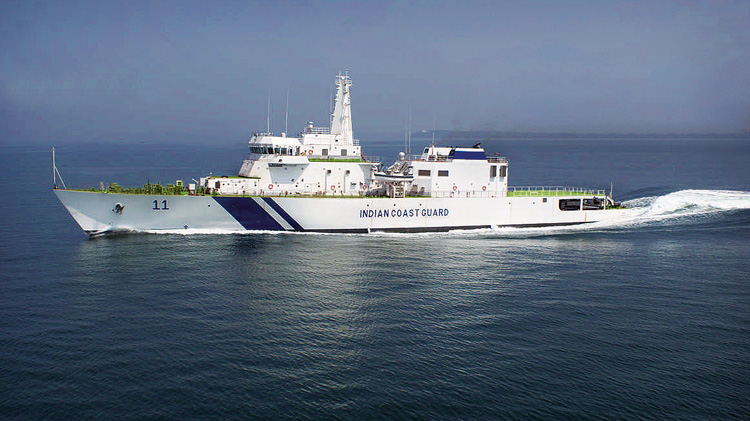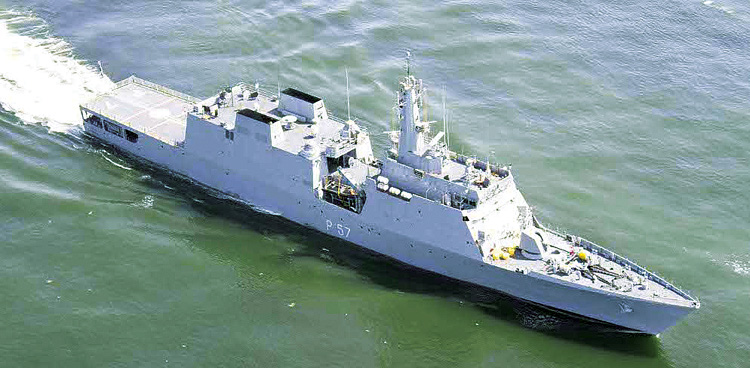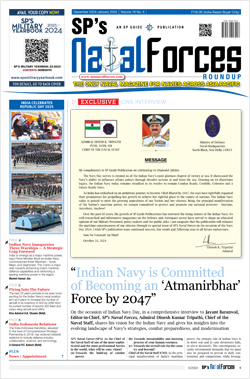INDIAN ARMED FORCES CHIEFS ON OUR RELENTLESS AND FOCUSED PUBLISHING EFFORTS

The insightful articles, inspiring narrations and analytical perspectives presented by the Editorial Team, establish an alluring connect with the reader. My compliments and best wishes to SP Guide Publications.

"Over the past 60 years, the growth of SP Guide Publications has mirrored the rising stature of Indian Navy. Its well-researched and informative magazines on Defence and Aerospace sector have served to shape an educated opinion of our military personnel, policy makers and the public alike. I wish SP's Publication team continued success, fair winds and following seas in all future endeavour!"

Since, its inception in 1964, SP Guide Publications has consistently demonstrated commitment to high-quality journalism in the aerospace and defence sectors, earning a well-deserved reputation as Asia's largest media house in this domain. I wish SP Guide Publications continued success in its pursuit of excellence.
- MoD initiates comprehensive review of Defence Acquisition Procedure 2020, pushes for defence reforms
- G7: The Swansong
- Kalinga Connect: South Asia to Polynesia
- Advanced MRSAM for India for a greater firepower
- Must Credit DRDO for Operation Sindoor, now what is next for defence R&D?
- Operation Sindoor | Day 2 DGMOs Briefing
- Operation Sindoor: Resolute yet Restrained
Coastal Security
Offshore Patrol Vessels Navy's Armed Patrol
“It is not surprising that some OPVs are multi-role and heavily armed, lighter scantling and faster, whereas others are larger, heavier, therefore slower, and equipped for the purposes of survey [and] pollution control. I think in the past some of the vessels which now come under the banner of OPV would have previously been called something else, such as corvette, light frigate or fishery protection vessel, but due to the current fad they fall under the generic term of OPV.”

A modern navy operates various types of warships to meet its diverse roles, from simple coastal patrols to power projection and warfighting. While the Indian Navy has aircraft carriers, cruisers, destroyers, frigates, submarines and missile boats for its offensive missions, it also has different class of ships for patrol, presence and support roles.
The grant of 200 nm exclusive economic zone (EEZ) and the extension from 3 nm to 12 nm of the maritime boundary/territorial waters of a nation brought to fore requirement of naval ships that could fulfill the roles of extended coastal security as well as provide security cover to the EEZ. The other coastal roles that are needed for the naval craft include, pollution control, search and rescue (SAR), law enforcement, firefighting, towing, etc. Larger naval ships cannot manoeuvre in the restricted and shallow coastal waters and would largely remain underutilised if deployed for EEZ patrols. This had given rise to the birth of offshore patrol vessel (OPV) class of ships. The OPVs, however, are being built to sizes and roles specific to a nation; they may range in size from a large attack craft to nearly a frigate size ship. They are proving economical for smaller nations because of their low cost and flexible roles. They are mainly being used for, extended coastal patrols, EEZ protection, maritime presence, law enforcement at sea, humanitarian assistance and disaster relief (HADR), and if needed, for Arctic or Antarctic ice patrols. The primary roles for the combat OPVs are anti-air warfare (AAW), antisubmarine warfare (ASW) and Anti-Surface Warfare (ASuW). They can be classified as combat OPVs and specific capability OPVs. The combat OPVs are faster and could be equipped with ASW, AAW, or ASuW weapon systems. These OPVs can take part in combat and meet the survivability standards of naval warships.
The majority of the combat role OPVs carry three types of weapons namely, a large/medium calibre main gun, a small calibre auxiliary gun, and a machine gun.
Weapons on Combat OPVs
While some nations have equipped their OPVs with Exocet and similar missiles, the majority of the combat role OPVs carry three types of weapons namely, a large/medium calibre main gun, a small calibre auxiliary gun and a machine gun. The machine gun is also carried by the onboard helicopter.
Main Gun. A warship’s main gun can be a large calibre or a medium calibre gun. Many navies prefer medium calibre guns like the Oto Melara 76mm, for their OPVs. The main gun’s maximum effective range is substantially higher than the auxiliary and the machine gun’s maximum effective ranges. Firing from long range is particularly important in conventional warfare, but not necessarily when fighting with terrorists. In littoral areas, there could be many merchant vessels, which could make it almost impossible to classify a ship at long distances. The only way to classify an unknown vessel from a long distance is with a helicopter. Therefore, even though the maximum effective range of the main gun ranges from 7,000 m to 10,000 m, the OPV would not be able to fire its main gun until the enemy boat is classified as hostile. The probability of hit is about 80 per cent at 500 m.
Auxiliary Gun. The auxiliary gun for the OPV is a small calibre gun for example a 30mm CIWS naval gun. The auxiliary gun’s presence is important especially when the OPV is not able to use its main gun for some reason. If the hit probability of the auxiliary gun is high, it can be a game changer.
Machine Guns. A machine gun, normally a 12.7mm, is operated by OPV personnel, and it has a relatively short effective range when compared to the ranges of the main and the auxiliary guns. Its main purpose is to warn other ships and to protect its own ship from small targets. The machine guns are very useful in crowded areas, since it is very difficult to classify a small boat from a long distance. It is also impossible to use missiles or long-range guns at shorter distances. Further, rules of engagement may not allow firing at hostile craft unless it approaches within a certain threatening range. In this case, the OPV can use its machine guns both for warning the approaching craft and for protecting itself. The probability of hit at 500 m is about 50 per cent; it increases as the distance to target decreases.

Onboard helicopter and its weapon. The high-speed capability of the helicopter makes it one of the most valuable assets of an OPV. It can perform search, detection, and reconnaissance operations in relatively short amounts of time, and with high accuracy. Technological advances also allow the helicopters to use cameras that help them to classify the targets. When the helicopter detects an unknown vessel, it moves towards that target for classification at its maximum speed, which ranges from 50 knots to 180 knots. The friendly craft have Automatic Identification System (AIS) which allow classification of almost all the vessels in the area. However, there could be some vessels that cannot be classified via AIS and thus could be identified by the helicopter. The classification distance may depend on weather conditions, capability of the camera, or the training of the operators. A 12.7mm machine gun is normally used on the helicopter.
Larger combat OPVs: Some examples:
UAE’s Baynunah class OPVs. These OPVs are designed to meet the requirements of combat patrols in the Strait of Hormuz. Their displacement is about 930 tonnes with full load, length of 71.3 m and top speed of 32 kt. The Baynunah class are fitted with missile systems including the MBDA Exocet MM40 Block 3 surfaceto-surface missile (SSM) and the Raytheon Evolved SeaSparrow Missile (ESSM) RIM-162 surface-to-air missile (SAM). The gun systems fitted are Oto Melara 76mm gun and two 27mm cannons. They also carry an organic helicopter, mine-avoidance sonar system (MASS) and decoy system, 3D radar and a full communications suite. These OPVs meet the AAW and ASuW requirements of the UAE for protection of its assets and merchant shipping in the region. The first of these OPVs was built in France by Constructions Mécaniques de Normandie, while the rest are being built in the UAE by Abu Dhabi Shipbuilding.
Khareef class OPVs. BVT of UK (now BAE Systems Maritime–Naval Ships) has built combat OPV, for Oman that have a length of 98.5 m with a displacement of 2500 tonnes. They carry Exocet anti-ship missile and Mica vertical-launch close-area air-defence systems.
Project Patrouilleschepen OPVs. Dutch shipbuilder Schelde Naval Shipbuilding (DSNS) has built four OPVs for the Royal Netherlands Navy under Project Patrouilleschepen. These ships are 108 m long, displace 3,750 tonnes and have a speed of up to 21.5 kt. They are to meet the requirement for patrol, surveillance and interdiction operations in the Netherlands EEZ. They carry a helicopter, a single 76mm gun, a 20-30mm gun and two machine guns.
Buque de Acción Maritima patrol ships. Navantia of Spain has already constructed four Buque de Acción Maritima patrol ships for the Spanish Navy. These are built to a modular design for protection of maritime resources; maritime interdiction; port security and counter-terrorism patrolling. These OPVs carry a helicopter and are armed with a single Oto Melara 76mm gun and two 20mm cannon, and fitted with the ‘Sistema de COMbate de los Buques de la Armada’ SCOMBA combat management system. Two more of the same OPVs are under construction.
Special Purpose OPVs
The specific capability OPVs are built to commercial standards and are equipped with lesser armament. They are rigged for specific role that they are designed for and may not be able to take part in battle at sea since they are bulkier and slower than the combat OPV. An area of developing role for OPVs are endurance and presence missions in the Arctic and Antarctic regions, which would necessitate changes in its design to meet operating conditions in broken ice. With the likely hood of opening up of Northwest Passage, it is expected that maritime trade from China and Japan would use this route for carting goods to Europe. Rolls-Royce has been designing OPV type ships for meeting the Arctic/Antarctic conditions. The Danish Arctic patrol ship, the Knud Rasmussen class is an example of such ships.
German OPVs. ThyssenKrupp Marine Systems of Germany has developed a series of 1,000/2,000-tonne OPVs. These are: a 67 m fast OPV; an 81 m Guardian class OPV displacing 1,800 tonnes; an 85 m, 1,900-tonne Sentinel class multimission OPV; and a larger 99 m version of the Sentinel OPV displacing 2,100 tonnes. Built to commercial standards, the vessels are equipped with a helicopter and boat capability, have modest speed, sensors and weapons equipment.
India
Tasks and role. As detailed in the website of the Indian Navy, in its constabulary role, the Indian Navy is employed to enforce law of the land or to implement a regime established by an international mandate. The protection and promotion of India’s maritime security is one of the Indian Navy’s prime responsibilities. This encompasses a constabulary role, where it relates to threats that involve use of force at sea. The tasks that the Indian Navy has to undertake in the constabulary role ranges from Low Intensity Maritime Operations to maintaining good order at sea. It also includes coastal security, as part of India’s overall maritime security. With the establishment of the Indian Coast Guard (ICG) in February 1978, law enforcement aspects of the constabulary role within the Maritime Zones of India (MZI) have been transferred to the ICG. Security in major harbours and ports are the purview of the port authorities, aided by customs and immigration agencies. Constabulary tasks beyond the MZI are vested with the Indian Navy. After the terrorist attacks on Mumbai on November 26, 2008, the overall responsibility for coastal security has been mandated to the Indian Navy, in close coordination with the ICG, State marine police and other central/state government and port authorities.
ICG. The ICG has been tasked to protect India’s maritime interests and enforce maritime law, with jurisdiction over the territorial waters of India, including its contiguous zone and exclusive economic zone. The ICG also operates OPVS. ICG deploys Samar class advanced OPVs having 2,005 tonnes displacement, Vishwast class OPVs (1,800 tonnes displacement) and Vikram class OPVs (displacement 1,220 tonnes). However, the number of OPVs appears insufficient to meet the requirement of patrolling and providing security to more than 7,000 km of coastline and Island territories of Andaman-Nicobar and Lakshadweep.
Indian Navy. The Indian Navy had started inducting the OPVs in the late 1980s, but the numbers inducted appear to be far less than that required to effectively safeguard the maritime assets, sea lines of communications and tackle sea pirates.

Made in India
Goa Shipyard Limited (GSL). GSL has been building a series of 105-m-long, 2,215-tonne OPVs for the Indian Navy. They are fitted with a 76mm naval gun and two 30mm cannons, and are capable of operating a single Dhruv helicopter.
Pipavav (now acquired by Reliance Defence). It is building naval offshore patrol vessels (NOPVs) which were delayed due to finance crunch but in June 2016, it was reported that the shipyard is now accelerating work on the delayed order where the first ship was supposed to be delivered in early 2015. As per the revised schedule, the first ship will now be delivered in early 2017 and all ships will be ready for induction by the end of 2017. The ships are being constructed in two batches of two and three ships with a shorter delivery schedule for the second batch. Significantly, the Indian Navy OPVs can also be modified to accommodate Twenty-foot Equivalent Unit (TEU) payloads, hence they can be considered as low cost warships with bigger roles.
Conclusion
OPVs have carved out a place for themselves mainly due to enhancement of territorial waters and the declaration of EEZ. The smaller nations too have equipped themselves with OPVs because of their versatility and low costs. The cost of the OPVs depend upon the combat systems and sensors required by a country to be put on board. To keep the costs low the combat system should therefore be mission specific and limited to the low-intensity capabilities. While OPVs are not equipped for full-fledged, combat they should be able to accomplish the constabulary tasks they are assigned to do. The OPV arena is set to expand with the likelihood of the opening of the North West Passage to Europe.





